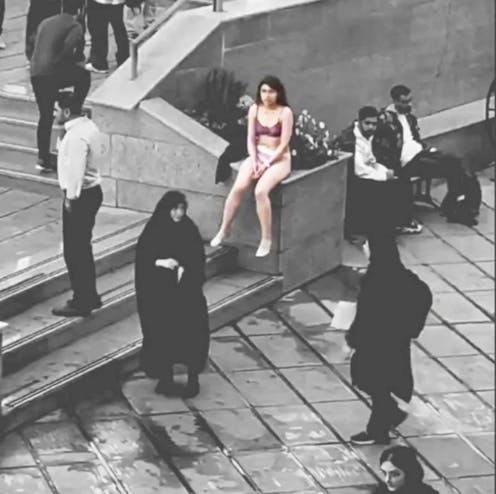
More than two years have passed since a young woman called Mahsa Amini died in police custody after being arrested in Iran for allegedly not wearing her hijab properly. Her death sparked mass protests throughout Iran against the country’s ruling theocracy.
The fight of Iranian women for freedom and bodily autonomy now rages on. Ahou Daryaei, a 30-year-old French language student at Tehran’s Islamic Azad University, has become the latest symbol of this resistance.
On November 2, Daryaei removed her clothing and walked onto the street in her underwear after an assault by members of the Basij paramilitary force, which is tasked with enforcing the country’s draconian dress code.
This powerful act, which was captured on video and shared widely on social media, lays bare the absurdity and brutality of Iran’s mandatory hijab laws. Daryaei’s defiance throws into sharp relief the regime’s relentless control over women’s bodies and its continued deep-seated misogyny.
The regime’s response was predictable and pathetic. One video shows security officers abducting Daryaei from the campus, while another shows her being bundled into a car by men in plain clothes.
In a post on X, formerly known as Twitter, a spokesperson for the university called Amir Mahjob said that Daryaei “had a mental disorder”. This is a tired tactic used to discredit and silence dissent that is all too familiar within Iran’s “Woman, Life, Freedom” movement, where women who dare to challenge the status quo are often labelled as mentally unstable.
Daryaei has not been seen since her arrest, and Iranian authorities are not saying where she is. But according to the Telegram channel for the Iranian newspaper, Farhikhtegan, she was taken to a police station and then transferred to a psychiatric centre. This blatant attempt to pathologise resistance only further highlights the regime’s desperation to maintain its grip on power.
Silencing dissent
Iran’s newly elected president, Masoud Pezeshkian, has promised to end morality police patrols. But his words ring hollow in the face of a recently passed hijab and chastity bill, which imposes harsh penalties including hefty fines and imprisonment on women who violate mandatory hijab rules. It also expands enforcement to online spaces and mobilises various institutions to police women’s dress.
Project Noor, a sister initiative launched in April to enforce hijab regulations, has already unleashed a wave of repression. Public spaces have been flooded with policemen, Basij paramilitary units, and plainclothes officers. Some universities, including Alzahra University in Tehran, have even deployed facial recognition technology at entry gates to deny access to students deemed to be in violation of the regime’s dress code.
These harsh laws represent a significant setback for human rights in Iran. The regime’s actions speak louder than words, and until women are truly free to choose how they dress, the fight for freedom in Iran will continue. Daryaei’s courageous act serves as a potent reminder that the flame of resistance burns bright, and the Iranian people will not be silenced.
Her protest, as Iranian-American lawyer Elika Eftekhari eloquently told Fox News, “may seem shocking to outsiders because it comes with the certainty of imprisonment, torture and rape as punishment from Islamic Republic officials”. Yet within this act of defiance lies tremendous fortitude. She has taken the regime’s misogyny “by the throat”, as Eftekhari puts it, “and ripped it to shreds through civil disobedience”.
Echoes of solidarity
Daryaei’s brave stand has ignited a firestorm of support. Students and activists across Iran have recognised her act as a powerful symbol of the fight for freedom. Her defiance echoes the spirit of countless Iranian women who have risked everything to challenge the regime’s oppressive laws.
But it also resonates with other powerful acts of resistance by women across the globe. It reminds me of the Tunisian feminist activist Amina Tyler, who posted topless photos of herself online in 2013 with the slogan “My body belongs to me and is not the source of anyone’s honor” written on her chest.
This act, like Daryaei’s, sparked controversy and death threats. But, despite not directly leading to regime change in Tunisia, it ignited further debates about women’s bodies and freedom of expression in the Muslim world. Tyler’s act became a symbol of resistance against patriarchal norms and the policing of women’s bodies.
As Masih Alinejad, an Iranian-American human rights activist, wrote on X (formerly Twitter) following Daryaei’s arrest: “She turned her body into a protest … Her act is a powerful reminder of Iranian women’s fight for freedom. Yes, we use our bodies like weapons to fight back at a regime that kills women for showing their hair … Be her voice. #WomanLifeFreedom.”
The message is clear: the Iranian people are ready for regime change, not merely empty reforms. The world must recognise Daryaei’s bravery and stand in solidarity with her by commenting, tweeting, and issuing statements in support of the Iranian people’s fight for freedom.
Hind Elhinnawy does not work for, consult, own shares in or receive funding from any company or organisation that would benefit from this article, and has disclosed no relevant affiliations beyond their academic appointment.
This article was originally published on The Conversation. Read the original article.







